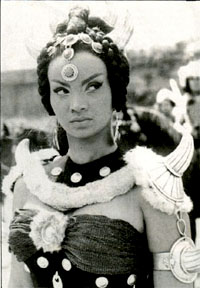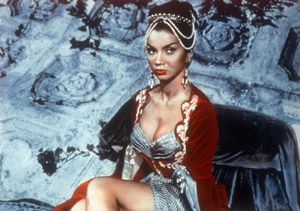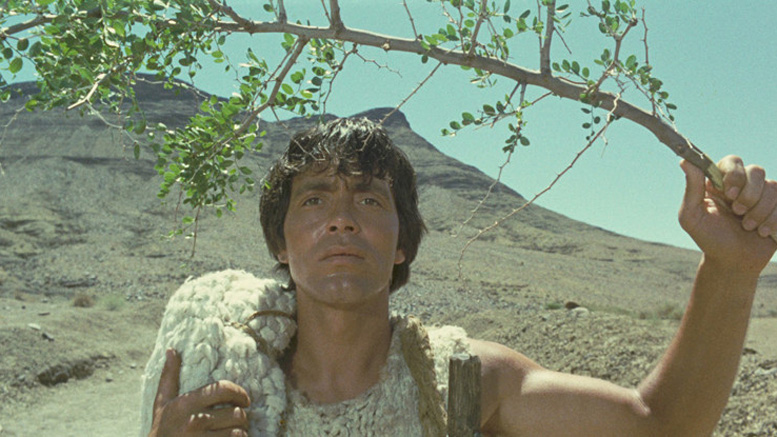
Chelo Alonso was, along with Bella Cortez, one of a handful of Cuban stars who made a name for themselves in Italy in the 1960s. A startlingly beautiful woman, she played on her exotic looks and tended to play feisty characters. Although she wasn’t perhaps the best actress in the world, she was certainly skillful enough to make an impression with the kind of material she had to work with.
Born Isabella Garcia in Central Lugareño on April 10th, 1933, she had a Cuban father and Mexican mother, which perhaps goes some way to explain her striking appearance. She soon made a name for herself as a dancer in her homeland, becoming an authentic crowd puller when appearing at the National Theatre in Havana.
As with many hopefuls from around the world, Europe beckoned, and after tours around the Caribbean and to Miami and New Orleans, she found employment at the Folies Bergère in Paris, where she mixed Afro-Cuban rhythmys with the more traditional bump and grind. Appropriately, perhaps, she was billed as ‘the Cuban H-Bomb’.
All the while, though, her ambition had been to be a film star, and with the Italian peplums entering their main phase of popularity, exotic looking women were in great demand, almost as much as the musclemen stars themselves. In 1959 she made her debut as a slave, dancer and conspirator in Guido Brignone’s Sign of the Gladiator (Nel Segno di Roma). It was a rapid ascent: thanks to an eye catching dance her billing was upped and she became the second female lead, and on much of the publicity material her name and portrait was more prominent even than that of the stars, much to Anita Ekberg’s displeasure. Capitalising on her notoriety, she rapidly appeared opposite Steve Reeves in Goliath and the Barbarians (Il terrore dei barbari), Lex Barker in The Pirate and the Slave Girl (La simitarra del Saraceno), Rik Battaglia in Attack of the Moors (I reali de Francia).
Her career progressed along with the popularity of the genre, and she made another half dozen peplums or historical adventure films over the next two years. Particualrly notable were Sergio Grieco’s entertaining The Queen of the Tartars (La regina dei tartari, 60), where she played a rather unlikely Tartar Queen, Antonio Leonviola’s wild Atlas Against the Cyclops (Maciste nella terra dei ciclopi, 61) and the big budget Andre De Toth film Morgan the Pirate (Morgan il pirata, 60), again with Reeves. By 1963 she was such a big name that Che Guevara tried to talk her into returning to Havana in support of his revolution.

The popularity of the peplums was shortlived, however, and by 1962 they were already falling out of fashion. Although she appeared in films from other genres – Luigi Filippo D’Amico’s war film Desert War (Quattro notti con Alba, 62), Marino Girolami’s comic ghost story La ragazza sotto il lenzuolo (61) – they weren’t as succesful, and after 1961, following her marriage to production manager Aldo Pomilia, she concentrated more on her television work, recording some songs and even on a cookery show.
She did, however, come out of her unofficial retirement for three important westerns, which unsurprisingly capitalised on her Mexican origins. Sergio Leone’s The Good, the Bad, and the Ugly (66), in which she had a small part as the unfortunate wife of Antonio Casas, murdered by Lee Van Cleef in one of the films most striking sequences; Sergio Sollima’s underrated Run, Man, Run (68), opposite Tomas Milian; and Giulio Petroni’s obscure Night of the Serpent (69).
After the death of her husband, Alsonso moved to Siena, retired from film and started a cat-breeding business and ran a four star hotel.
Here’s an interesting article from La Stampa in 1959 (my own rough’nready translation):
Chelo Alonso talks about her frightening adventure
The condition of the actress Chelo Alonso, left injured yesterday in a frightening accident, was thought not to be of concern tonight, and already she has been able to be discharged from the hospital and returned to her home in Via Rodolfo Lanciani N74
At the time of the incident, the actress was returning to Rome from Doganella, a place near Mauriana, a small town near Bracciano, where she was shooting exteriors for the film I reali de Francia, which she stars in alongside Rik Battaglia. Chelo’s car was preceded by Battaglia’s who, in taking a sharp turn at high speed, saw the car behind them suddenly swerve and, after overturning, crash into a tree. Battagliai made a rapid turn and returned back immediately, finding the actress and her secretary covered with blood and broken glass.
Struck with ‘shock’, Alonso continued to hysterically sound the horn and scream in terror. The actor, overcoming his initial moment of bewilderment, extracted the young actress from the twisted metal of the car and transported her to the Civil Hospital of Bracciano in his car. Soon after, he returned to the scene of the incident to pick up the secretary, Germaine Heute, 57, who had remained, weeping, jammed in the machine.
At the hospital, the two injured women were immediately visited by doctors Ceciarelli Mario and Claudio Ferranti. The actress was found with wounds to her face and right hand and bruises to the head and left leg, in addition to a severe state of shock. The secretary had an injury to her left wrist and a suspected fracture of the ulna. Both are considered curable within five days.
Chelo Alonso, Once she recovered from the shock and was able to speak, spoke of her terrible adventure: “I had just taken a big turn when, at some point, I lost control of the steering wheel. It must have locked and I could not handle it. With dread I heard the car skidding dangerously and I saw the trees of the road turn around wildly inside. In that brief moment which preceded the tremendous impact, my life flashed in front of me. Later, when I realized that I had lost plenty of blood from my face, I was terrified that my film career would be cut short.”
